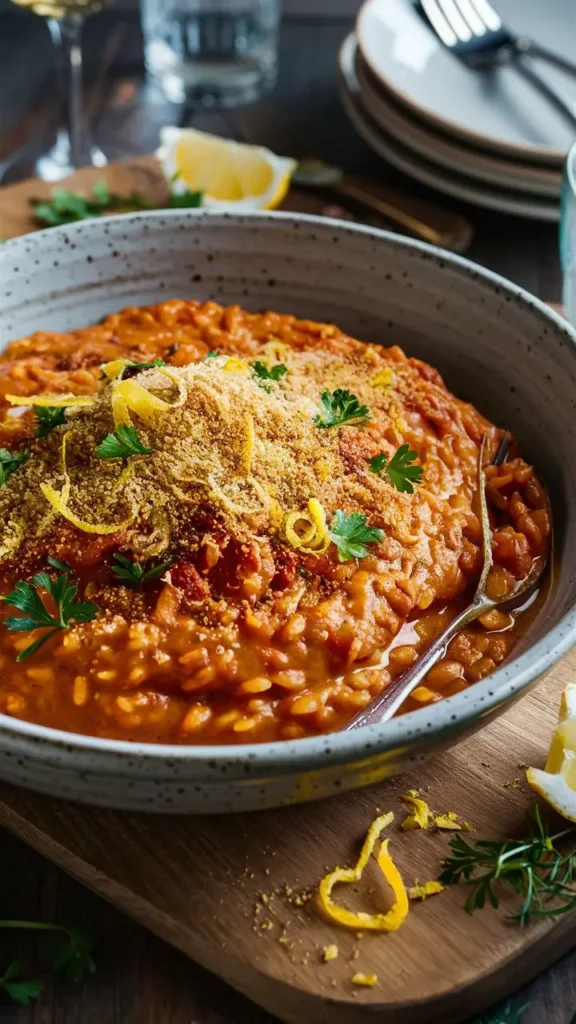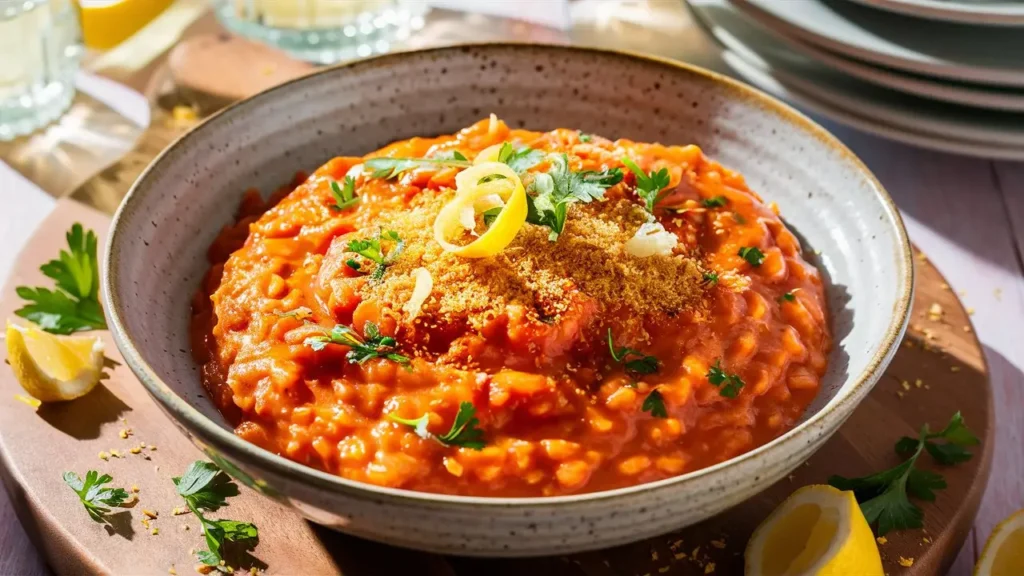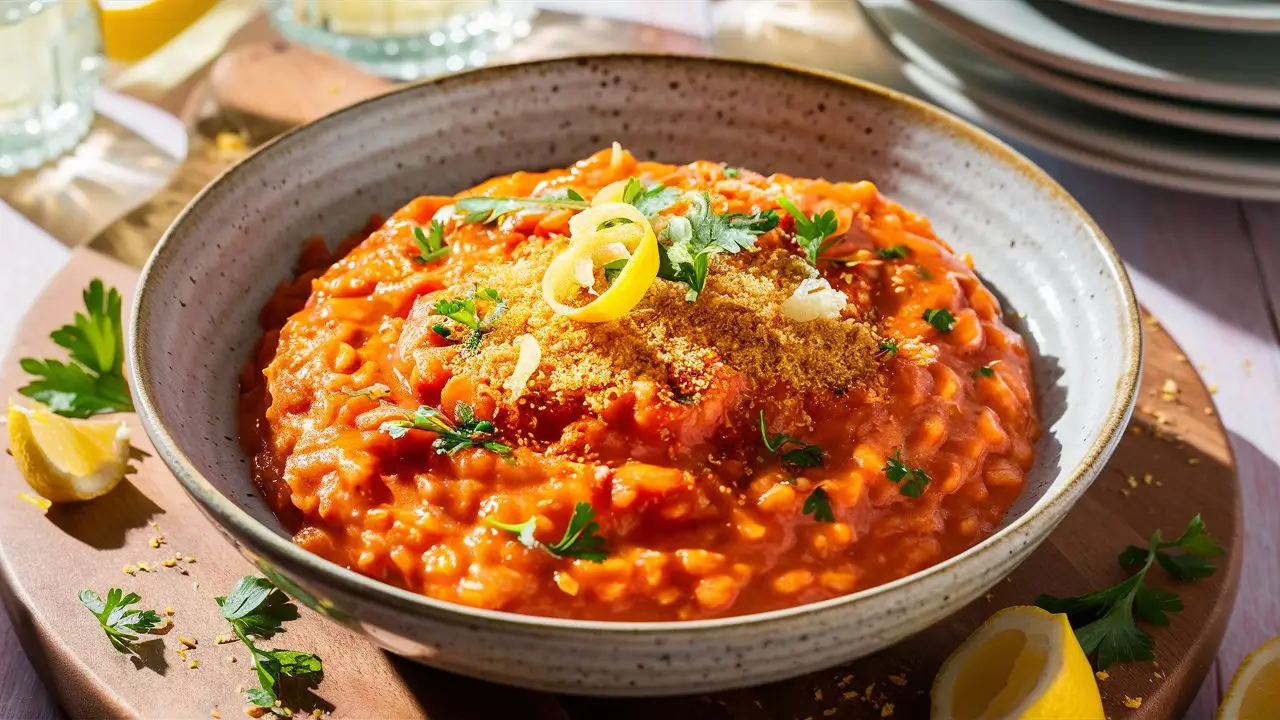If you’re a fan of comforting, creamy, and deeply flavorful dishes, risotto is a recipe worth mastering. A staple in Northern Italian cuisine, risotto is made from Arborio rice and cooked slowly by gradually adding broth, creating a rich, velvety texture that’s hard to resist. While it may seem fancy or difficult at first, risotto is surprisingly simple once you understand the method.
Why You Will Love Making Risotto at Home
-
Elegant Yet Comforting – Creamy and satisfying with a refined touch.
-
Flexible Ingredients – Great for using fresh vegetables, meats, or seafood.
-
Naturally Gluten-Free – Made with rice, not pasta or flour.
-
Great for Dinner Parties – Easy to elevate with gourmet toppings or wine pairings.
What Is Risotto?
Risotto is an Italian rice dish cooked slowly by adding warm broth in small amounts and stirring frequently. This technique releases the starches from the rice, resulting in a creamy texture without using cream. It originated in the Lombardy and Piedmont regions of Italy and is traditionally made with short-grain rice like Arborio, Carnaroli, or Vialone Nano.
Ingredients List
-
1½ cups Arborio rice
-
4–5 cups warm chicken or vegetable broth
-
2 tbsp olive oil or butter
-
1 small onion or shallot, finely chopped
-
½ cup dry white wine (optional but traditional)
-
½ cup grated Parmesan cheese
-
Salt and black pepper to taste
-
Optional: fresh herbs or lemon zest for finishing
Timing & Servings
-
Prep Time: 10 minutes
-
Cook Time: 30–35 minutes
-
Total Time: 40–45 minutes
-
Servings: 4
How to Make Classic Risotto (Step-by-Step)
Step 1: Heat the Broth
Warm your broth in a saucepan and keep it on low heat during the entire cooking process. Adding cold broth to the rice can interrupt the cooking.
Step 2: Sauté Aromatics
In a large skillet or saucepan, heat olive oil or butter over medium heat. Add the chopped onion or shallot and cook until soft and translucent—about 3–4 minutes.
Step 3: Toast the Rice
Add the Arborio rice to the pan and stir for 2–3 minutes. This step coats the grains with oil and slightly toasts them, which enhances flavor.
Step 4: Deglaze with Wine
Pour in the white wine and stir until it’s mostly absorbed. This adds acidity and depth of flavor.
Step 5: Add the Broth Gradually
Begin adding warm broth, one ladle at a time, stirring constantly. Wait until the liquid is nearly absorbed before adding more. Continue this process for 18–20 minutes.
Step 6: Finish with Cheese and Butter
Once the rice is tender but still slightly firm in the center (al dente), remove from heat. Stir in Parmesan and a bit of butter for richness.
Step 7: Serve Immediately
Risotto is best served hot and fresh, with a sprinkle of cheese or fresh herbs on top.

Tips for the Perfect Risotto
1. Stir Often, But Not Constantly
Stirring frequently helps release the starches, but over-stirring can make it gluey. Find a balance.
2. Use Warm Broth
Cold broth slows cooking and affects texture. Always keep it simmering nearby.
3. Don’t Rush It
Good risotto takes time. Gradual liquid absorption is key to creaminess.
4. Taste as You Go
The best way to avoid overcooked or undercooked risotto is to taste often, especially toward the end.
5. Finish with Flavor
Parmesan, lemon zest, truffle oil, or herbs can enhance the finished dish beautifully.
Popular Risotto Variations to Try
1. Mushroom Risotto
Sauté a mix of mushrooms with garlic and thyme. Add to the risotto toward the end of cooking and finish with a drizzle of truffle oil.
2. Lemon and Asparagus Risotto
Add chopped asparagus in the last 10 minutes of cooking. Finish with lemon zest and juice for a bright, spring flavor.
3. Shrimp Risotto
Sear shrimp separately and add to the risotto during the last few minutes. Garnish with fresh parsley and chili flakes.
4. Pumpkin or Butternut Squash Risotto
Stir in roasted pumpkin purée or small squash cubes with a pinch of nutmeg. Perfect for fall dinners.
5. Tomato and Basil Risotto
Add diced fresh tomatoes or tomato purée halfway through cooking. Finish with torn basil leaves and mozzarella.
How to Make Vegan or Dairy-Free Risotto
-
Use vegetable broth instead of chicken.
-
Replace Parmesan with nutritional yeast or a dairy-free cheese.
-
Use olive oil in place of butter.
-
Add extra herbs and roasted vegetables for flavor depth.
What to Serve with Risotto
While risotto is often hearty enough on its own, it pairs beautifully with these sides:
-
Grilled or roasted vegetables
-
Simple green salad with vinaigrette
-
Garlic bread or crusty baguette
-
Roasted chicken or fish
-
Sautéed greens like spinach or kale
How to Store and Reheat Risotto
Storing Leftovers:
-
Cool completely before transferring to an airtight container.
-
Refrigerate for up to 3 days.
-
Not ideal for freezing—risotto changes texture when thawed.
Reheating Tips:
-
Reheat gently on the stovetop with a splash of broth or water.
-
Microwave on low power, stirring every 30 seconds, and add liquid if needed.
-
Avoid overcooking during reheating to preserve texture.
Can You Use Other Rice Types for Risotto?
While Arborio is most common, here are a few alternatives:
-
Carnaroli: Preferred by many chefs for its ability to hold shape and absorb liquid.
-
Vialone Nano: Slightly smaller grain, very creamy.
-
Pearled barley or farro: For a rustic twist—note that the technique may differ slightly.
-
Do not use long-grain rice like basmati or jasmine—they lack the starch needed for creaminess.
Risotto vs. Rice Pilaf: What’s the Difference?
-
Risotto is cooked slowly with broth added gradually, resulting in a creamy consistency.
-
Pilaf is cooked by sautéing rice in oil and then simmering in liquid all at once, yielding fluffy, separate grains.
-
Different techniques, different textures—but both delicious in their own right.
FAQs
Q1: Is risotto hard to make?
Not at all! It just requires patience and attention. Once you learn the method, it becomes easy and rewarding.
Q2: Can I make risotto ahead of time?
Risotto is best fresh, but you can partially cook it (75% done), cool it quickly, and finish it just before serving.
Q3: Can I use pre-shredded cheese?
It’s better to use freshly grated Parmesan—pre-shredded cheese doesn’t melt as well and may contain anti-caking agents.
Q4: How do I know when risotto is done?
It should be al dente—tender with a slight bite—and have a creamy consistency that spreads on the plate.
Q5: What’s the best wine for risotto?
Use dry white wines like Pinot Grigio, Sauvignon Blanc, or even a dry Chardonnay.
Conclusion
Risotto might have a reputation for being fussy, but once you understand the rhythm of stirring, adding broth, and tasting, it becomes one of the most rewarding dishes you can make at home. It’s creamy, comforting, elegant, and endlessly adaptable. From earthy mushroom risotto to bright lemon asparagus, there’s a version of this classic Italian dish for every season and every table.
So grab some Arborio rice, warm up some broth, and let yourself enjoy the simple luxury of homemade risotto—because once you do, you’ll want to make it again and again.
